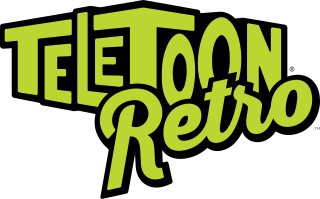
CHUM Limited was a Canadian media company based in Toronto, Ontario in operation from 1945 to 2007. The company was founded in 1945 as York Broadcasters Limited when it launched CHUM-AM 1050 but was acquired by salesman Allan Waters in 1954. CHUM had expanded to and owned 33 radio stations across Canada under its CHUM Radio Network division and also owned other radio stations.

Cartoon Network is a Canadian English-language discretionary specialty channel owned by Corus Entertainment. The channel primarily broadcasts animated series aimed at children and teenagers. It was launched on October 17, 1997, by Teletoon Canada, Inc., a consortium of Western International Communications and Astral Media, Shaw Communications, and the animation studios Cinar and Nelvana. With subsequent acquisitions and divestments, Corus became the sole owner of the channel in 2014.

Corus Entertainment Inc. is a Canadian mass media and television production company. The company was founded in 1987 as Shaw Radio Ltd. as a subsidiary of Shaw Communications and was spun-off from Shaw in 1999. It has prominent holdings in the radio, publishing, and television industries. Corus is headquartered at Corus Quay in Toronto, Ontario.

Family Channel is a Canadian English-language specialty channel owned by WildBrain Television Inc., a subsidiary of WildBrain. The network primarily airs children's television series, teen dramas, as well as other programming targeting a family audience. Despite having its own headquarters in the Brookfield Place office in Financial District, the channel is transmitted from Corus Quay.

CMT is a Canadian English language discretionary specialty channel owned as a joint venture between Corus Entertainment and Paramount Networks Americas, owners of the flagship CMT channel in the United States.

Oprah Winfrey Network, more commonly shortened to OWN, was a Canadian English language discretionary service channel owned by Corus Entertainment. The network's owner, Corus Entertainment, licensed the OWN brand and its American programming from Warner Bros. Discovery.
Cooking Channel was a Canadian English language discretionary specialty channel majority-owned by Corus Entertainment. Dedicated to programming related to food and cooking, it serves as a spin-off of Food Network.

Movie Central was a Canadian English language Category A premium cable and satellite television channel that was owned by Corus Entertainment. Movie Central was designated to operate west of the Ontario-Manitoba border, including the territories. Although the channel's name implies that it focuses solely on theatrically released motion pictures, Movie Central's programming included original and foreign television series, made-for-cable movies and documentaries.

CoolTV was a Canadian English language category 2 digital cable specialty channel dedicated to the musical genres of jazz, blues and world music; including music videos, movies, concerts, and television series. Based in Winnipeg, Manitoba, CoolTV was owned by Canwest Media, a division of Canwest Global Communications.
Rogers Media Inc., operating as Rogers Sports & Media, is a Canadian subsidiary of Rogers Communications that owns the company's mass media and sports properties.

Stingray Juicebox is a Canadian discretionary music specialty channel owned by Stingray Group. It is a commercial-free channel that broadcasts music and music videos aimed towards children and teens.

TLN is a Canadian English-language discretionary specialty channel owned by TLN Media Group. The channel primarily broadcasts lifestyle programming surrounding the cultures of Latin America and Italy, including cooking and travel-related programs, as well as coverage of international soccer, and mainstream television series and films.

Home Network is a Canadian English-language discretionary cable and satellite specialty channel owned by Corus Entertainment. Home Network broadcasts programs relating to real estate, home and garden design, and renovations.

Teletoon Retro was a Canadian specialty channel that was owned by Corus Entertainment that was based on the Teletoon programming block. The service was dedicated to broadcasting classic animated television programs such as The Raccoons as well as some live-action series.
Stingray Music is a Canada-based international multi-platform audio service that broadcasts continuous streaming music and other forms of audio on multiple channel feeds. The service is owned by Stingray Digital.
Boom FM is a branding of classic hits radio stations broadcasting in Canada. The trademark is owned by Bell Media, although only two stations using the branding are owned by that company.

Télétoon Rétro was a Canadian French language Category B specialty television channel that was owned by Corus Entertainment. The channel was based on the former Télétoon programming block Télétoon Retro and was dedicated to broadcasting French-dubbed animated series that had premiered on television at least 10 years prior to their airing on Télétoon Retro. Along with its English language sister station, Teletoon Retro, combined, both were available in over 9 million Canadian households as of 2013, having the most subscribers among the digital Canadian specialty channels.

AMI-tv is a Canadian, English-language, digital cable specialty channel owned by the non-profit organization Accessible Media. AMI-tv broadcasts a selection of general entertainment programming with accommodations for those who are visually or hearing impaired, with audio descriptions on the primary audio track and closed captioning available across all programming.
Stingray Group Inc. is a Canadian music, media and technology company based in Montreal, Quebec, with offices in Toronto, Ontario, as well as in the United States, Mexico, the United Kingdom, the Netherlands, Germany and Australia.

Magnolia Network is a Canadian exempt discretionary specialty channel owned by Rogers Sports & Media. Based on the U.S. cable network of the same name, It broadcasts personality-based programming related to home construction, improvement, and cuisine.
















